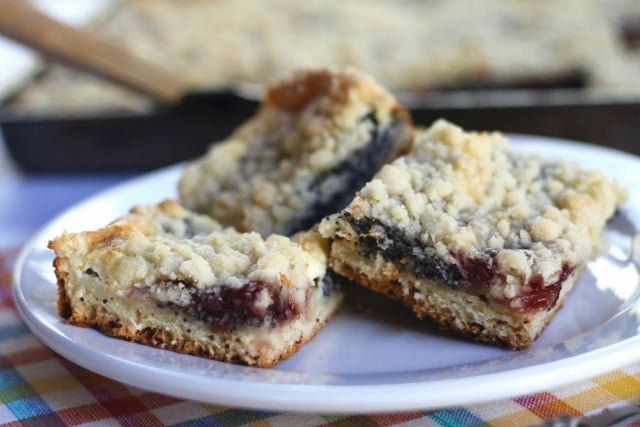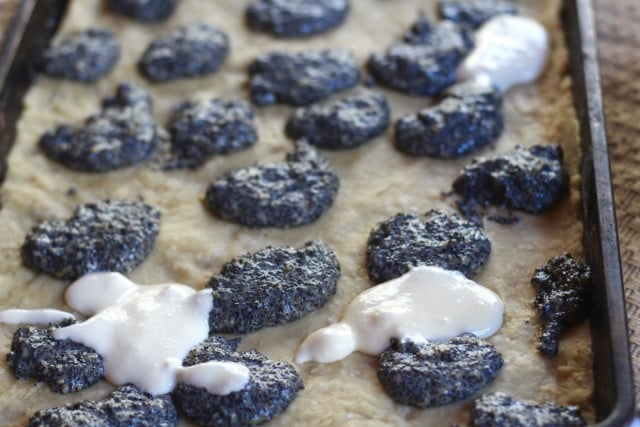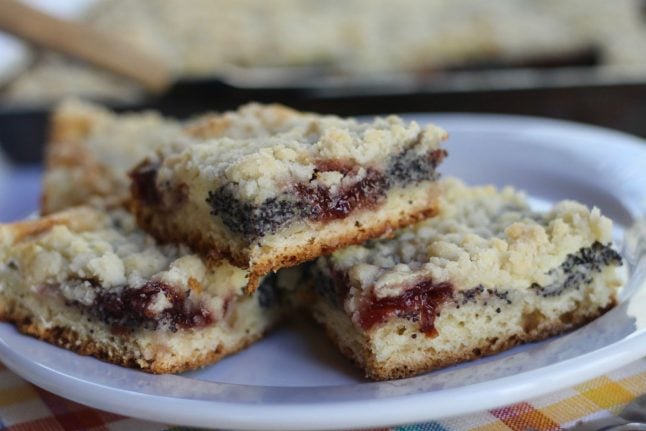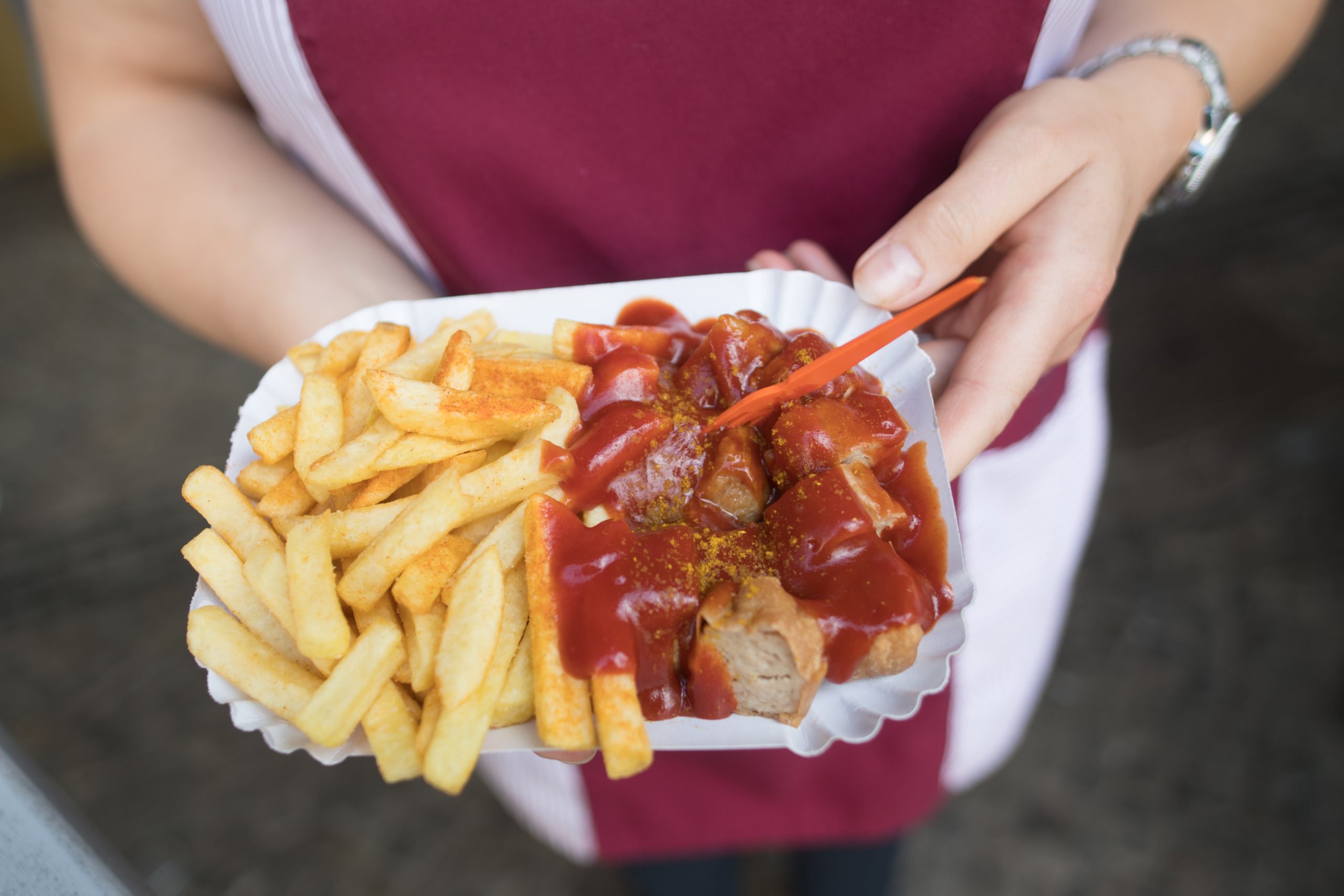This streusel-topped cake is a specialty of Oberlausitz, or the Upper Lusatia region of Germany and Poland dating back to the 1400s.
Kleckskuchen is fun to make with kids. However, if you are concerned about the tablespoon of rum in the poppy seed filling and cherry jam, just leave it out.
Alternatively, substitute vanilla extract. Instead of cherry jam, use any variety, or a mixture of jams you have on hand. This is a great opportunity to get rid of those pesky half and quarter full jars left in your fridge.
The recipe makes a lot of cake. Consequently, it’s an ideal dessert to bring to potlucks or any sort of festivity this summer.
However, it also freezes well. Make sure you wrap each individual piece in plastic cling film and seal them in a ziplock bag before tossing into the freezer.

The final product. Photo courtesy of Lora Wiley
Kleckskuchen – Cherry Poppy Seed Streusel Cake
Prep Time: 45 minutes
Rise time: 1 hour 5 minutes
Bake time: 30 minutes
Yield: 20 pieces
Ingredients:
For the cake base:
• 400g flour
• 125ml lukewarm milk
• 30g wet yeast
• 60g white granulated sugar
• 100g butter, melted
• 1 egg
• 1/2 teaspoon salt
For the poppy seed filling:
• 1 tablespoon lemon zest
• 250ml milk
• 20g unsalted butter
• 30g semolina or spelt flour
• 100g crushed poppy seeds
• 50g white granulated sugar
• 1 egg
• 1 tablespoon rum
• 1/4 teaspoon cinnamon
For the sour cream filling:
• 1 egg
• pinch of salt
• 250g quark
• 4 tablespoons milk
• 80g white granulated sugar
• 1 teaspoon pure vanilla extract
For the streusel:
• 175g flour
• 100g white granulated sugar
• 1/2 package vanilla sugar
• 100g melted butter
Topping:
• 250g cherry jam
• 1 tablespoon rum

Learn how to make this tasty poppy seed filling. Photo courtesy of Lora Wiley
Directions:
Make the cake base:
• Place the flour in a bowl. Make a well in the middle of the flour.
• Add 3 tablespoons of the lukewarm milk and break up the yeast into the
milk.
• When the yeast starts to bubble, add the sugar and rub the mixture
between your hands to distribute the yeast.
• Cover the bowl and let stand in a warm place for 15 minutes.
• Add the melted butter, the rest of the milk, egg and salt and knead
together into a smooth dough.
• Cover the bowl once again and let stand 15 minutes.
• Line a 25 cm x 35 cm sheet pan with baking paper. Grease the sides.
• Roll out the dough into a rectangle, transfer it to the pan and spread it out
to the edges.
• Let stand for 20 minutes.
Make the poppy seed filling:
• Mix together the lemon zest, milk, butter and semolina in a skillet and
bring to a boil.
Reduce the heat to low and simmer for 5 minutes. The mixture should become thick like pudding.
• Let cool and whisk in the poppy seeds, sugar, egg, rum, and cinnamon.
Make the sour cream filling:
• Separate the egg.
• Place the egg white in a mixer, add the pinch of salt.
• Beat the egg white until stiff peaks form.
• Mix together the quark, milk, egg yolk, sugar and vanilla.
• Fold the egg white into the mixture.
Make the streusel:
• Whisk together the flour, sugar and vanilla sugar.
• Add the melted butter. Use your hand or a fork to mix together until
the streusel forms.
Assemble the cake:
• Mix the cherry jam together with the rum. Cover the cake layer, alternating
with tablespoon sized blobs of the poppy seed filling, sour cream filling, and the jam.
• Sprinkle the streusel over the top and let the cake stand for another 15
minutes.
• Preheat the oven to 175 degrees C.
• Bake for 25-30 minutes.
• Remove from oven. Let cool. Cut and serve.





 Please whitelist us to continue reading.
Please whitelist us to continue reading.
Member comments